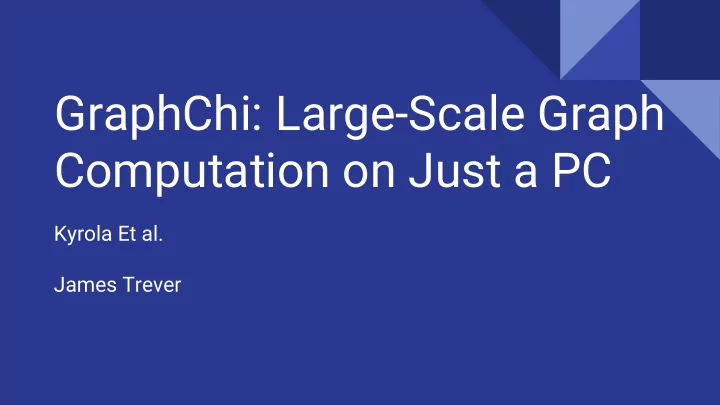

GraphChi: Large-Scale Graph Computation on Just a PC Kyrola Et al. James Trever
Could we compute Big Graphs on a single machine? Disk Based Computation
Why would you want to? - Distributed State is hard to program - Cluster crashes can occur - Cumbersome - Efficient Scaling - Parallelise each task vs Parallelise across tasks - Cost - Easier management and simpler hardware - Energy Consumption - Full utilisation of a single computer - Easier Debugging
- Computational Model Contents - Challenges - Parallel Sliding Windows - Implementation & Experiments - Evolving Graphs
Computational Model
Computational Model
Storage Model - Compressed Sparse Row (CSR) - allows for fast loading of out-edges - Compressed Sparse Column (CSC) - allows for fast loading of in-edges
Storage Model - Compressed Sparse Row (CSR) - allows for fast loading of out-edges - Compressed Sparse Column (CSC) - allows for fast loading of in-edges Why not both?
Challenges
Random Access Problem 1.3 - Symmetrised adjacency file with values
Random Access Problem 1.3 - File Index Pointers
Possible Solutions 1. Use SSD as memory extension Too many small objects, need millions of reads and writes a second ○ 2. Compress the graph structure to fit in RAM ○ Associated values do not compress well 3. Cachine the hot vertices ○ Unpredictable Performance
Parallel Sliding Windows (PSW)
PSW: Phases PSW processes the graph one sub-graph at a time 1. Load 2. Compute 3. Write In one iteration the whole graph is processed
PSW: Intervals and Shards - Load - Subgraph = Interval
PSW: Example - Load
PSW: Example - Load
PSW: General Example - Load
PSW: Compute Phase - UpdateFunction executes on intervals vertices in parallel - Edges have pointers to the loaded data blocks
PSW: Write Phase - Blocks are written back to disk asynchronously
Implementation and Experiments
Preprocessing Step - Sharder program included with GraphChi 1. Counts the in-degree of each vertex and computes the prefix sum over the degree array so that each interval contains same number of in edges 2. Sharder writes each edge to temporary scratch file belonging to the shard 3. Sharder Processes each scratch file 4. Sharder computes binary degree file containing in and out degree for each vertex (used to calculate memory requirements)
Preprocessing Experiment
Comparison Experiment Mac Mini Dual Core 2.5 GHz, 8GB Ram AMD Server 8 core server with 4 dual core CPU’s
Throughput Experiment
Evolving Graphs
Evolving Graphs - Add and remove edges in streaming fashion whilst continuing computation - Most interesting networks grow continuously
PSW and Evolving Graphs
PSW and Evolving Graphs
Evolving Graphs - Experiment
Graphs Used
Critical Evaluation - Few mistakes in the paper referencing incorrect tables or quoting wrong figures - Cannot efficiently support dynamic ordering like priority ordering or efficiently support graph traversals or vertex queries - Evolving graph experiments not very clear - No monetary analysis
Bibliography A. Kyrola, G. Blelloch, and C. Guestrin, “Graphchi: Large-scale graph computation on just a pc,” in Proceedings of the 10th USENIX Conference on Operating Systems Design and Implementation, OSDI’12, (Berkeley, CA, USA), pp. 31–46, USENIX Association, 2012. And his original presentation found here: https://www.usenix.org/sites/default/files/conference/protected- files/kyrola_osdi12_slides.pdf
Recommend
More recommend